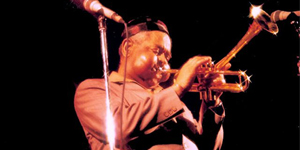Just found this online (posted 3/21/07)
I wrote it for SiteProNews.com in order to drum up support for New Orleans among Internet geeks. I waited so long to hear if they were going to publish it, I’d forgotten all about it. Thanks Google.
Strange, they didn’t bother to put in paragraph breaks. It’s a bit long winded, but it tells the whole story for those who are interested in the subject.
Here it is in a readable version:
Can the web save the world?
In a word, yes.
And here’s the qualifier: “One piece at a time.”
Web activism has been part of my personal agenda for as long as I’ve been involved with the web.
In 1994, when I organized and sponsored the first conference on web marketing ever (Marc Andreessen gave the keynote), I invited all the usual suspects: ad agencies, PR firms, tech magazine writers – and NAMAC, the National Alliance of Media Arts and Culture.
Why did I want to bring a non-profit group of independent filmmakers to the table for a discussion about the future of the web?
Because I felt then, and feel even more strongly today, that the work of independent media producers is essential for the pursuit of social justice and positive change in our society.
My then-extravagant hope was that some day we’d sort out compression issues and bandwidth limitations and be able to stream independently produced video across the net as an antidote to television.
Now that day has arrived. What are we going to do with it?
Save the world, of course, one piece at a time.
Saving a city
A city is a pretty good-sized piece and seven years ago some friends and I sat around my kitchen table and tried to figure out how we were going to save a little city that we loved. Just two miles square and sitting on the banks of the Hudson River, the City of Hudson appeared destined for obliteration.
Here’s what we were facing:
The second largest cement company in the world was planning to build the largest coal-fired cement plant in North America right next to town.
Cement plants are third only to oil refineries and chemical plants in the amount of health-damaging pollutants they produce. The plant which would run 24/7 was just a mile from schools, the city’s hospital and New York State’s retirement/long term care facility for retired firemen.
And here’s the really bad part: Not only was every local politician and every local media outlet in favor of the plant, an atmosphere of intimidation hung over the city that frightened many local people into keeping quiet about their concerns. The company was prepared to spend – and indeed did end up spending – $50,000,000 on advertising, PR, lobbyists, attorneys, and donations to local groups.
On our side: Fifty people and fifty bucks.
Six and a half years later, in a conflict that lasted longer than World War II, the fifty people with fifty bucks won.
How?
It’s a long story (see the “Additional Reading” below), but it all boiled down to this: we used the media we had – hand painted signs, meetings, flyers, the mail, the web – to build a membership organization that grew large enough to counterbalance and ultimately overcome what I think most reasonable people would have thought was an unbeatable force.
Today, I find myself thinking a lot about another city.
Saving our soul
There are two kinds of people in the world: Those who have been initiated into the glories of New Orleans and those who have not yet had the pleasure.
Until June of 2006, I fell in the latter category.
Then my old friend Steve O’Keefe, one of the Internet’s earliest commercialization pioneers, invited me to come visit. He’d been living in the city for the last ten years pursuing a passion we both share, music.
To say that I was stunned by the depth, breadth and sheer vitality of the music culture of New Orleans would be an understatement. How could I have missed this all my life? Understand, I’m a huge jazz fan. I’ve produced jazz concerts, hosted a jazz radio show, managed a jazz record label – and I never “got” New Orleans. (It might have something to do with growing up in New York City. I *assumed* my home town was the only place that mattered.)
Anyway, the city’s music scene is only the outer manifestation of something that is rapidly disappearing from North American society: communities…real neighborhoods, where people know each other, celebrate and mourn together, and support each others’ creative endeavors. For too many people, New Orleans equals Bourbon Street, a Disney-like tourist trap where frat boys misbehave and puke on each others shoes.
That’s not New Orleans.
The real New Orleans is indescribably profound, creative, human and it holds a big piece of America’s soul – and the real New Orleans is dying.
Un-spinning the spin
Like so many stories the mass media sells us, the story of New Orleans has been spun to such an extreme that the reality and the reporting might as well be from different planets. For example:
Myth #1: Hurricane Katrina destroyed New Orleans, right? Wrong.
The storm did little damage. It was the catastrophic failure of over one dozen federally built and maintained levees that caused the vast majority of the damage.
Myth #2: The citizens of the city were disorganized, reckless and lawless. Wrong.
The pre-hurricane evacuation was one of the largest and most successful rapid movements of a civilian population in history. Those who were trapped by the flood waters caused by the collapsed levees were overwhelmingly peaceful and participated in countless acts of heroism, often risking their own lives to save others and feed and care for the most vulnerable.
Myth #3: The hurricane was over eighteen months ago, they should be over it by now.
Wrong.
Tell me what city could recover from the loss of 200,000 houses, 81,000 businesses, 175 schools and 6 major hospitals in a year? In two years? In ten? Per capita damage to Louisiana was a mind boggling $6,700 per state citizen. Compare this to New York after 9/11 ($390) or Hurricane Andrew which devastated South Florida ($139.)
What happened in New Orleans was the equivalent level of destruction of total war. After World War II, otherwise self-reliant and capable cities like Berlin and Tokyo and many, many others needed massive, prolonged infusions of outside assistance to get back on their feet.
So what’s going on?
Bottom line: The federal government – whose negligence caused the disaster in the first place – has made the decision that it’s cheaper, politically and financially, to let New Orleans die, rather rebuild it.
Thus the constant drumbeat of media propaganda that the city was destroyed by “an act of nature,” that its people are inherently corrupt and unworthy, that no one should live there. This last point is especially preposterous. If no one should live in New Orleans, no one should live in Holland either. The difference is Dutch levees don’t collapse.
You can probably see where this is leading.
Internet pros volunteers needed for New Orleans
New Orleans needs independent media to tell its story. Not just for the sake of telling a story, but to organize and rally all the people in the US and around the world who love the city and what it stands for – and there are millions of them currently unconnected.
Who’s going to do that?
More precisely, who’s going to create the media infrastructure that will make it easy for New Orleanians to tell their story and easy for outsiders who care to target their help where it will do the most good – both on the neighborhood level and in Washington.
Cities are savable. Even in the darkest times. I know. Hudson was savable. I believe New Orleans is savable too.
– Ken McCarthy
FoodMusicJustice
====
Update: January 2, 1010
A year after this, a friend and I made a ten minute video explaining the reality of what really caused the destruction of New Orleans.
After posting it to YouTube on the third anniversary of the levee failures, we threw all our promotional weight behind it in an coordinated effort with Levees.org.
All throughout the Democratic and Republican conventions we managed to stay in the Top #13 news videos. We even retained our position during the Sarah Palin lunacy.
All in all, over 90,000 people have viewed the video on YouTube.
You can see it by going to the Levees.org web site. It’s right on the home page.
If you’d like to help New Orleans, one of the fist things you should do is become a levees.org member and add your voice to the people who are demanding that a real investigation be done into the failure of the levees there.
It’s a city worth saving and much more needs to be done.
Visit: http://www.levees.org







